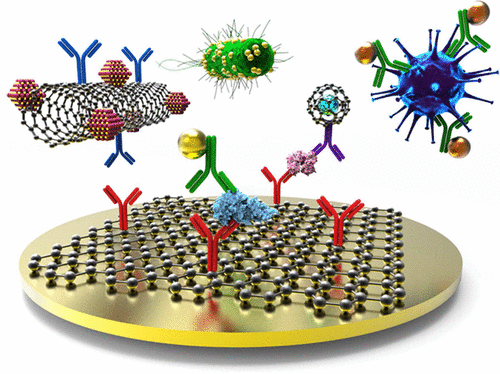当前位置:
X-MOL 学术
›
Chem. Rev.
›
论文详情
Our official English website, www.x-mol.net, welcomes your
feedback! (Note: you will need to create a separate account there.)
Nanoparticle-Based Immunochemical Biosensors and Assays: Recent Advances and Challenges
Chemical Reviews ( IF 51.4 ) Pub Date : 2017-07-28 00:00:00 , DOI: 10.1021/acs.chemrev.7b00037 Zdeněk Farka 1 , Tomáš Juřík 1 , David Kovář 1 , Libuše Trnková 1 , Petr Skládal 1
Chemical Reviews ( IF 51.4 ) Pub Date : 2017-07-28 00:00:00 , DOI: 10.1021/acs.chemrev.7b00037 Zdeněk Farka 1 , Tomáš Juřík 1 , David Kovář 1 , Libuše Trnková 1 , Petr Skládal 1
Affiliation

|
We review the progress achieved during the recent five years in immunochemical biosensors (immunosensors) combined with nanoparticles for enhanced sensitivity. The initial part introduces antibodies as classic recognition elements. The optical sensing part describes fluorescent, luminescent, and surface plasmon resonance systems. Amperometry, voltammetry, and impedance spectroscopy represent electrochemical transducer methods; electrochemiluminescence with photoelectric conversion constitutes a widely utilized combined method. The transducing options function together with suitable nanoparticles: metallic and metal oxides, including magnetic ones, carbon-based nanotubes, graphene variants, luminescent carbon dots, nanocrystals as quantum dots, and photon up-converting particles. These sources merged together provide extreme variability of existing nanoimmunosensing options. Finally, applications in clinical analysis (markers, tumor cells, and pharmaceuticals) and in the detection of pathogenic microorganisms, toxic agents, and pesticides in the environmental field and food products are summarized.
中文翻译:

基于纳米粒子的免疫化学生物传感器和测定:最新进展和挑战
我们回顾了近五年来在免疫化学生物传感器(免疫传感器)与纳米颗粒相结合以提高灵敏度方面取得的进展。初始部分介绍了抗体作为经典识别元素。光学传感部分描述了荧光,发光和表面等离振子共振系统。安培法,伏安法和阻抗谱代表电化学换能器方法。光电转换的电化学发光构成了一种广泛使用的组合方法。转换选项与合适的纳米粒子一起起作用:金属和金属氧化物,包括磁性粒子,碳基纳米管,石墨烯变体,发光碳点,作为量子点的纳米晶体和光子上转换粒子。这些来源合并在一起,为现有的纳米免疫传感选择提供了极大的可变性。最后,总结了在环境领域和食品中在临床分析(标记,肿瘤细胞和药物)以及病原微生物,有毒物质和农药的检测中的应用。
更新日期:2017-07-28
中文翻译:

基于纳米粒子的免疫化学生物传感器和测定:最新进展和挑战
我们回顾了近五年来在免疫化学生物传感器(免疫传感器)与纳米颗粒相结合以提高灵敏度方面取得的进展。初始部分介绍了抗体作为经典识别元素。光学传感部分描述了荧光,发光和表面等离振子共振系统。安培法,伏安法和阻抗谱代表电化学换能器方法。光电转换的电化学发光构成了一种广泛使用的组合方法。转换选项与合适的纳米粒子一起起作用:金属和金属氧化物,包括磁性粒子,碳基纳米管,石墨烯变体,发光碳点,作为量子点的纳米晶体和光子上转换粒子。这些来源合并在一起,为现有的纳米免疫传感选择提供了极大的可变性。最后,总结了在环境领域和食品中在临床分析(标记,肿瘤细胞和药物)以及病原微生物,有毒物质和农药的检测中的应用。











































 京公网安备 11010802027423号
京公网安备 11010802027423号